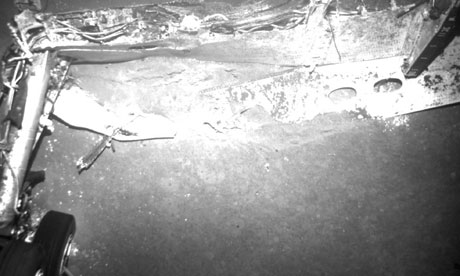Robot submarines reveal wreckage with bodies of passengers who died when Flight AF477 went down on its way to Rio

The images from the ocean bed were a cause for celebration for the team of investigators on board the Alucia, off the northern coast of Brazil.
After the information was relayed back to Paris, it fell to Nathalie Kosciusko-Morizet, minister for ecology and transport, to break the news. "There are bodies still in the part [of the plane] that has been found," she told French radio. "I'm not an expert, but it appears the whole thing didn't explode … there is a part of the cabin, and in that part of the cabin there are bodies" – bodies, she added, "that could be possibly identified". She said France would begin an operation to bring the wreckage and human remains to the surface within the next few weeks as the search to find the plane's flight recorders, the black boxes that may solve the mystery of the crash, continues.
The recovery operation will cost an estimated €5m (£4.4m) and will be financed by the French state, but is expected to cause controversy and arguments between relatives of the victims.
Robert Soulas, vice-president of a support group for the victims' families, said raising the bodies was a thorny question. Among those killed were passengers from France, Britain, Brazil, Italy, Ireland and China. Among several children to die on the flight was the 11-year-old British schoolboy Alexander Bjoroy, who was travelling back to the UK with a chaperone after spending the half term break with his parents in Brazil.
"There's a very traumatic side to this and it causes problems of identification. We don't know what state they are in. And it risks causing a dispute between families who want to leave the bodies at the bottom of the Atlantic and those who want them brought to the surface," Soulas said.
For the families of those who died in the tragedy on 1 June 2009, the discovery of the wreckage marked the first breakthrough in nearly two years and brought a mixture of hope and despair. "We want to know what happened in that plane," said Michel Gaignard, who lost his sister in the accident.
An unnamed lawyer for several of the families said some had still not come to terms with their loss. "There's been no burial, no goodbye … just lots and lots of suffering," he told French radio.
In the days after the crash about 50 bodies and parts of the plane – notably the tailfin – were pulled from the sea by the Brazilian navy. But since then there has been nothing.Continued
For nearly two years, searchers have been scouring the Atlantic on and off in the hope of finding the Air France Airbus A330-200 that fell out of the sky on its way from Rio to Paris, and there it was. At least part of it – a pair of wheels resting on the seabed nearly 4,000 metres from the surface, two engines and a large part of the fuselage – was still intact.
Then, from the sunless depths, came other images no one had expected. As the Remus robot submarines swept the submerged wreckage, there, clearly visible, were the bodies of some of the 228 passengers who perished when flight AF447 plunged into the sea, several still strapped into their seats.After the information was relayed back to Paris, it fell to Nathalie Kosciusko-Morizet, minister for ecology and transport, to break the news. "There are bodies still in the part [of the plane] that has been found," she told French radio. "I'm not an expert, but it appears the whole thing didn't explode … there is a part of the cabin, and in that part of the cabin there are bodies" – bodies, she added, "that could be possibly identified". She said France would begin an operation to bring the wreckage and human remains to the surface within the next few weeks as the search to find the plane's flight recorders, the black boxes that may solve the mystery of the crash, continues.
The recovery operation will cost an estimated €5m (£4.4m) and will be financed by the French state, but is expected to cause controversy and arguments between relatives of the victims.
Robert Soulas, vice-president of a support group for the victims' families, said raising the bodies was a thorny question. Among those killed were passengers from France, Britain, Brazil, Italy, Ireland and China. Among several children to die on the flight was the 11-year-old British schoolboy Alexander Bjoroy, who was travelling back to the UK with a chaperone after spending the half term break with his parents in Brazil.
"There's a very traumatic side to this and it causes problems of identification. We don't know what state they are in. And it risks causing a dispute between families who want to leave the bodies at the bottom of the Atlantic and those who want them brought to the surface," Soulas said.
For the families of those who died in the tragedy on 1 June 2009, the discovery of the wreckage marked the first breakthrough in nearly two years and brought a mixture of hope and despair. "We want to know what happened in that plane," said Michel Gaignard, who lost his sister in the accident.
An unnamed lawyer for several of the families said some had still not come to terms with their loss. "There's been no burial, no goodbye … just lots and lots of suffering," he told French radio.
In the days after the crash about 50 bodies and parts of the plane – notably the tailfin – were pulled from the sea by the Brazilian navy. But since then there has been nothing.Continued

No comments:
Post a Comment